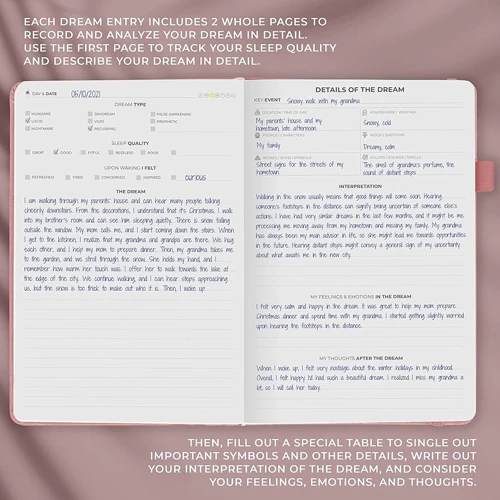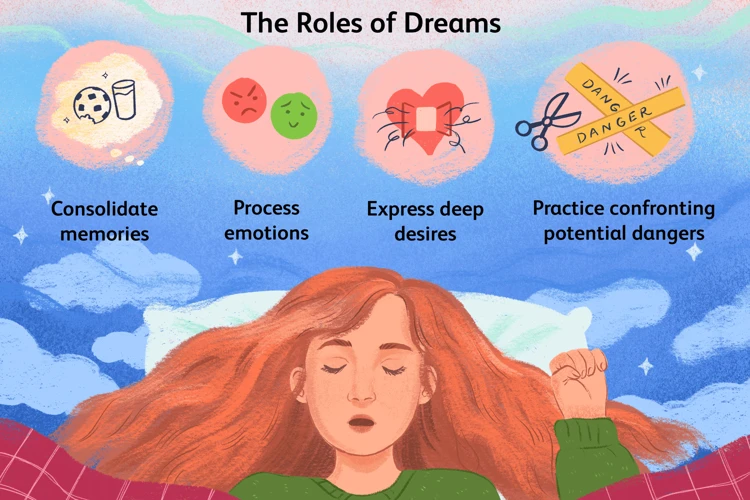Do you ever wake up from a vivid dream, only to have it fade away as you start your day? Dreams have a mysterious way of captivating our minds and leaving us with a sense of wonder. What if there was a way to not only remember our dreams but also gain insights from them? Enter dream journaling, a practice that allows us to record our dreams in intricate detail, unlocking a world of symbolism and hidden meanings. In this article, we will explore the fascinating realm of dream journaling and how it can be utilized to decipher the enigmatic messages that our dreams hold.
Why Should You Keep a Dream Journal?

Keeping a dream journal can be a powerful tool for unraveling the mysteries of our dreams. By actively recording our dreams, we create a tangible record that allows us to revisit and analyze the intricate details of each dream. Dream journaling provides several benefits that make it a worthwhile practice. Firstly, it helps improve dream recall, as the act of writing down our dreams signals to our subconscious mind that we value and want to remember them. Additionally, dream journaling allows us to identify patterns and recurring themes in our dreams, providing valuable insights into our subconscious desires and fears. By keeping a dream journal, we can establish a deeper connection with our inner selves and explore the depths of our subconscious mind. It also acts as a personal documentation of our dream experiences, which can be fascinating to look back on over time. Overall, keeping a dream journal is a gateway to understanding the hidden messages that our dreams hold and provides a pathway to personal growth and self-discovery.
Benefits of Dream Journaling
Keeping a dream journal offers a multitude of benefits that can enhance our understanding of our dreams and promote personal growth. Firstly, dream journaling improves dream recall by training our brains to remember dreams more vividly. This allows us to capture even the most intricate details of our dreams, enabling us to analyze them with greater accuracy. Through the process of journaling, we can identify patterns and recurring themes in our dreams, uncovering hidden messages and gaining insights into our subconscious desires and fears. Dream journaling also acts as a creative outlet and serves as a form of self-expression, helping us to process emotions and experiences symbolically. Additionally, a dream journal provides a personal record of our dream journey, allowing us to reflect on our progress and discoveries over time. By diligently maintaining a dream journal, we open ourselves up to analyzing recurring themes in dreams and tapping into the rich tapestry of our subconscious desires.
How Dream Journaling Works
Understanding how dream journaling works is key to unlocking its potential benefits. When we engage in dream journaling, we capture the essence of our dreams by recording detailed descriptions, images, and emotions. The process begins by placing a journal or notebook next to our bed, within easy reach upon waking. As soon as we wake up, we retrieve our dream journal and start jotting down everything we can remember about our dreams. It’s important to do this immediately upon waking, as dreams tend to fade quickly from memory. By writing down our dreams, we create a physical record that allows us to revisit and reflect upon them later.
Dream journaling involves capturing various elements of our dreams. This can include specific symbols, themes, people, or events that stood out during the dream. It is essential to describe the emotions and feelings experienced in the dream as well. This information provides valuable insights into the subconscious aspects of our dreams and can help uncover hidden meanings.
To make the dream journaling process easier, consider using bullet points or creating a table with columns for symbols, emotions, and themes. This helps organize the information and makes it easier to review and analyze later. It can also be beneficial to review and analyze our dream journal entries regularly, looking for patterns or connections between different dreams. This can be accomplished by using techniques such as mind mapping or creating visual representations of the dreams and their elements.
By consistently practicing dream journaling and delving into the depths of our dream experiences, we gain a deeper understanding of the symbolism and messages our dreams hold. This knowledge allows us to explore and interpret our dreams from a personal perspective, as our own unique experiences and life events shape the symbols and meanings encountered in our dreams. Dream journaling serves as a bridge between our conscious and subconscious mind, providing a pathway for self-discovery and personal growth.
Getting Started with Dream Journaling

To begin your dream journaling journey, it’s important to set up a dedicated space for recording your dreams. Find a notebook or journal that resonates with you. It could be a sleek and simple notebook or a beautiful journal with intricate designs. The key is to choose something that feels special and inspires you to write. Consider keeping your dream journal by your bedside, making it easily accessible for late-night or early-morning dream recordings. Decorate the cover or add personal touches to make it uniquely yours.
Consistency is key when it comes to dream journaling. Establishing a regular routine will train your mind to prioritize dream recall and make it easier to remember your dreams. Dedicate a few minutes each morning to jotting down any dreams you remember from the night before. Make it a ritual by pairing it with a comforting morning beverage or quiet meditation. Consistency will strengthen your dream recall skills over time.
To kickstart your dream journaling routine, you may also explore techniques like setting an intention before sleep, such as repeating the phrase “I will remember my dreams” or visualizing yourself recording your dreams. These practices can help train your mind to focus on dream recall.
Remember, the key is to find a routine that works for you and fits into your lifestyle. Whether you prefer to journal immediately upon waking or after a few moments of reflection, find the approach that feels most natural and enjoyable to you.
Setting Up Your Dream Journal
Setting up your dream journal is the first step towards embarking on the insightful journey of dream interpretation. There are a few key considerations to ensure that your dream journal is organized and effective. Firstly, choose a journal or notebook that is dedicated solely to recording your dreams. This can be a physical journal or a digital journaling app, depending on your preference. Next, create sections or categories within your journal to help organize your entries. Consider dividing your journal based on dates, themes, or emotions. Alternatively, you can create a separate page for each dream entry and use labels or tags to categorize them. To make your entries more detailed, include important information such as the date, time, and location of the dream. Setting up your dream journal in an organized and systematic way will make it easier to navigate and analyze your dreams in the future.
Creating a Dream Journaling Routine
Creating a dream journaling routine is essential to establish a consistent practice and maximize the benefits of recording and interpreting your dreams. Here are some steps to help you create an effective dream journaling routine:
1. Choose a journal: Select a dedicated journal or notebook specifically for recording your dreams. Opt for something that you feel drawn to and enjoy writing in.
2. Keep it by your bedside: Place your dream journal next to your bed, along with a pen or pencil. This ensures it’s easily accessible as soon as you wake up from a dream.
3. Set an intention: Before sleep, make a conscious intention to remember your dreams and write them down in your journal. This primes your mind to actively recall and engage with your dreams.
4. Write immediately upon waking: As soon as you wake up, grab your dream journal and jot down any details, emotions, or fragments of the dream that you can recall. Don’t worry about perfect grammar or sentence structure; focus on capturing the essence of the dream.
5. Include relevant details: Write down as much information as possible about the dream, such as locations, people, objects, or any significant events or symbols. Be sure to include your emotional reactions and feelings during the dream.
6. Use sketches or diagrams: If you’re inclined to visual representation, consider adding sketches or diagrams alongside your written entries. These can help capture the imagery and visuals of your dreams.
7. Reflect and analyze: Periodically review your dream journal entries to identify recurring themes, symbols, or patterns. Reflect on the emotions and experiences you had during the dreams and see if you can make any connections to your waking life.
By establishing a regular dream journaling routine, you create a habit that enhances your dream recall, deepens your understanding of your dreams, and promotes self-reflection and personal growth. Stick with it and allow yourself the space to explore the limitless realms of your subconscious mind.
Interpreting Dreams Using Journal Entries

Interpreting dreams using journal entries is a key step in uncovering the deeper meanings and messages within our dreams. Each dream journal entry serves as a treasure trove of symbols, emotions, and themes that can be decoded and analyzed. One important aspect of interpreting dreams is identifying dream symbols and themes. As we review our journal entries, we can highlight and analyze the recurring symbols or themes that appear in our dreams. This process allows us to recognize patterns and gain a deeper understanding of their significance. Another vital element in dream interpretation is analyzing emotions and feelings associated with the dream. By reflecting on our emotions during and after the dream, we can uncover hidden desires, fears, or unresolved issues that our subconscious mind is attempting to bring to our attention. Additionally, recognizing recurring patterns in our dreams can provide valuable insights into our subconscious thoughts and behaviors. As we scrutinize our dream journal entries, we can identify patterns such as recurring locations, actions, or interactions, which can offer clues to unresolved experiences or behavioral patterns. By delving into our dream journal entries and actively engaging in dream interpretation techniques, we can unlock the fascinating world of our subconscious mind and gain a greater understanding of ourselves.
Identify Dream Symbols and Themes
One of the key aspects of deciphering dreams through journaling is the ability to identify dream symbols and themes. As we delve into the pages of our dream journal, we begin to notice recurring symbols or themes that appear throughout our dreams. These symbols can be objects, people, or even scenarios that hold deeper meanings. By identifying dream symbols and understanding their significance, we can gain valuable insights into our subconscious mind. For example, dreaming about water may symbolize emotions, while animals can represent specific personality traits or instincts. By recognizing these symbols and themes, we can start to piece together the puzzle of our dreams and unravel the hidden messages they hold. Analyzing dream symbols allows us to gain a deeper understanding of ourselves and our inner thoughts and desires, ultimately leading us to personal growth and self-discovery.
Analyze Emotions and Feelings
When analyzing our dreams, it’s important to pay close attention to the emotions and feelings that we experienced during the dream. Our dreams often serve as a reflection of our subconscious emotions, and by delving into these emotional aspects, we can gain deeper insights into our inner selves. One way to analyze emotions and feelings is to create a list or table in your dream journal, where you can categorize and record the emotions you experienced in each dream. For example, you may have felt a sense of fear, excitement, joy, or sadness. Next to each emotion, jot down any specific details or events in the dream that may have elicited these emotions. This exercise helps in identifying patterns and recurring emotional themes in your dreams. By understanding the emotions and feelings expressed in our dreams, we can uncover unresolved emotional issues, unfulfilled desires, or areas of personal growth that need attention. It’s worth mentioning that your personal experiences and beliefs can influence the interpretation of emotions in dreams. For instance, someone who has a fear of water may experience feelings of anxiety in a dream involving water. It’s crucial to consider the influence of personal experiences on your dream interpretation. Analyzing emotions and feelings is a vital step toward deciphering the meaning and significance behind our dreams.
Recognize Recurring Patterns
Recognizing recurring patterns in our dreams is a key aspect of dream interpretation. By identifying patterns that appear across multiple dream entries, we can gain valuable insights into our subconscious mind and the underlying themes that often go unnoticed. One way to recognize recurring patterns is to review our dream journal entries and make note of any similarities or common elements that appear. This could include recurring symbols, settings, or even specific emotions that consistently emerge in our dreams. By organizing this information in an html table or html list, we can visually analyze the patterns and connections between different dreams. This visual representation allows us to spot similarities that might have otherwise gone unnoticed. For example, we might notice a recurring symbol like a butterfly, which could represent transformation or freedom. Alternatively, we may discover that we frequently dream about being chased, indicating underlying anxieties or feelings of being overwhelmed. Recognizing recurring patterns provides us with a deeper understanding of our dreams and allows us to explore the common themes that shape our subconscious mind. As we delve into these patterns, we can begin to unravel the hidden messages and meanings behind our dreams, ultimately leading to personal growth and self-discovery.
Common Dream Symbols and Their Meanings

Dreams often contain a myriad of symbols that can hold significant meaning. Understanding the symbolism behind common dream symbols can help us interpret our dreams more effectively. Water is a symbol that frequently appears in dreams and can represent the subconscious mind, emotions, and spiritual purification. It may indicate the need to delve into our emotions or navigate through life’s challenges. Animals in dreams can symbolize various qualities or aspects of ourselves and our relationships with others. For example, a dog may represent loyalty and companionship, while a snake could represent transformation or hidden fears. Falling is another common dream symbol that often signifies a loss of control or a fear of failure. It may also indicate a need to let go and trust the process. It’s important to remember that dream symbols can have personal associations, so it’s essential to consider our own experiences and feelings when interpreting them. By recognizing and exploring the meanings behind these common symbols, we can gain deeper insights into the messages our dreams are trying to convey.
Water
Water is a common symbol that frequently appears in dreams, carrying various interpretations depending on the context. One possible meaning of water is its association with emotions and the subconscious mind. In dreams, calm and serene water may signify a sense of inner peace and emotional stability. On the other hand, turbulent or turbulent water can represent emotional turmoil or unresolved feelings. The depth and clarity of the water may also indicate the depth of emotions or the clarity of one’s thoughts. In some instances, water can be a symbol of purification or renewal, symbolizing the need to cleanse oneself emotionally or start fresh. It is important to consider the specific details and emotions surrounding water in a dream to decipher its unique meaning for the individual. By analyzing the symbolism of water in dreams, we can gain valuable insights into our emotional state and delve deeper into our subconscious desires.
Animals
are a common presence in our dreams and hold symbolic meanings that can offer insights into our subconscious mind. When interpreting animal symbols in dreams, it is important to consider the characteristics and behaviors associated with each particular animal. For example, a wolf in a dream may represent instinct, intuition, or a need for independence. A bird, on the other hand, could symbolize freedom, inspiration, or an upcoming opportunity. The appearance of a snake might be associated with transformation, healing, or hidden fears. It is essential to pay attention to the emotions and interactions we have with these animals in our dreams, as they can provide further clues to their significance. Understanding the symbolism of animals in our dreams can help us gain a deeper understanding of ourselves and our current life situations. It is worth noting that personal experiences and cultural influences may also impact the interpretation of animal symbols in dreams. By recognizing and exploring the symbolism of animals in our dreams, we can tap into the rich tapestry of our subconscious minds and unlock new perspectives on our lives and experiences.
Falling
The dream symbol of falling is one that is commonly experienced by many people. When we dream of falling, it can evoke a range of emotions and leave us with a sense of vulnerability. In the realm of dream interpretation, falling is often associated with a loss of control or a fear of failure. It can symbolize a lack of stability or an overwhelming sense of insecurity in waking life. However, it is important to note that the interpretation of this symbol can vary based on the individual’s personal experiences and emotions. For some, falling in a dream may represent a desire to let go and surrender to the uncertainties of life, while for others, it may indicate a need to regain control and find stability. To gain a deeper understanding of the meaning behind falling in your dreams, it is essential to consider the context of the dream, your emotions during the dream, and any recurring patterns that may be present. By delving into the symbolism of falling in your dream journal, you can uncover valuable insights into your subconscious fears and aspirations.
Tips and Techniques for Advanced Dream Interpretation

When it comes to advanced dream interpretation, there are various tips and techniques that can enhance our understanding of the symbolism and messages within our dreams. Dream associations can be a powerful tool in this process. By examining the various objects, people, or situations in our dreams and noting any personal or emotional connections we have with them, we can begin to unravel their significance. For example, if we dream of a butterfly and associate it with freedom and transformation, it can suggest a period of personal growth or change in our waking life. Another technique is lucid dreaming, where we become aware that we are dreaming while still in the dream. This state of awareness allows us to actively engage with the dream and even influence its outcome, providing valuable insights into our subconscious mind. Journaling prompts can also be helpful in advanced dream interpretation. By using specific questions or prompts to explore different aspects of our dreams, we can delve deeper into their meanings and uncover hidden messages. These prompts could include exploring the emotions felt during the dream, analyzing the relationships between dream characters, or examining the settings and environments of the dream. By employing these tips and techniques, we can take our dream interpretation to a more advanced level and gain a deeper understanding of ourselves and our inner world.
Dream Associations
Dream associations are a powerful technique that can be used to uncover the deeper meanings behind our dreams. By examining the various elements and symbols within a dream, we can make connections to our personal experiences, emotions, and memories. Dream associations involve analyzing the different aspects of a dream and brainstorming any related thoughts, feelings, or events that come to mind. This can be done through the use of a table or list, where each dream symbol or element is listed, and associations are written next to them. For example, if you dreamt of a bird, you might associate it with freedom, soaring high, or a particular bird species that holds significance to you. By exploring these associations, we can gain a deeper understanding of the messages our dreams are trying to convey and the underlying emotions they are connected to.
Lucid Dreaming
Lucid dreaming is an extraordinary phenomenon that occurs when we become aware that we are dreaming while still in the dream. This heightened state of consciousness within the dream allows us to have control over our actions, surroundings, and even the outcome of the dream itself. Lucid dreaming can be an exciting and transformative experience, offering a unique opportunity for self-exploration and personal growth. Here are some key insights and techniques to help you explore the world of lucid dreaming:
1. Reality checks: Practice reality checks throughout the day by questioning your surroundings and questioning whether you are dreaming. This habit will translate into your dreams, making it more likely for you to recognize the dream state.
2. Dream journaling: Keep a dedicated section in your dream journal to record any lucid dreams you experience. This not only helps improve dream recall but also reinforces the intention to have future lucid dreams.
3. Visualization and intention setting: Before going to bed, visualize yourself becoming lucid in a dream. Repeat affirmations such as, “I will be aware that I am dreaming” or “I will have a lucid dream tonight.” This programming of the mind increases the likelihood of becoming aware in the dream state.
4. Mnemonic induction of lucid dreams (MILD): This technique involves waking up after 5-6 hours of sleep, recalling a recent dream, and then visualizing yourself becoming lucid in that dream. Repeat this process while falling back to sleep, focusing your intention on becoming lucid.
5. Wake back to bed (WBTB): Set an alarm to wake you up after 4-6 hours of sleep. Stay awake for a short period (around 20-30 minutes) and engage in activities such as reading about lucid dreaming or practicing relaxation techniques. Then go back to bed with the intention of having a lucid dream.
6. Reality testing within dreams: Once you are in a dream, perform reality checks to confirm whether you are dreaming or not. This can include trying to push your finger through your palm, looking at clocks or text and seeing if they change, or trying to levitate. If the reality check fails and the dream state is confirmed, you become lucid.
Lucid dreaming offers an incredible opportunity for exploration and self-discovery within the realm of dreams. By practicing techniques and incorporating them into your dream journaling routine, you can increase your chances of experiencing lucid dreams and unlock a world of limitless possibilities within your dreamscapes.
Journaling Prompts
When it comes to dream journaling, sometimes we may find ourselves at a loss for where to start or what to write about. Journaling prompts can be incredibly helpful in overcoming writer’s block and inspiring deeper exploration of our dreams. Here are some journaling prompts to get you started:
- Reflect on the emotions: Write about the emotions you experienced during your dream. Did you feel fear, joy, sadness, or confusion? Reflecting on the emotions can provide insight into your subconscious state.
- Explore symbolism: Identify any symbols or recurring themes in your dream. Are there any objects, people, or locations that stand out? Reflect on their meaning or significance to you personally.
- Interpret the narrative: Write a detailed account of your dream’s storyline. What events or interactions took place? Consider what the narrative could represent or symbolize in your waking life.
- Connect with personal experiences: Explore any connections between your dream and your personal experiences. Are there any parallels or similarities? Reflect on how your past or current circumstances may be influencing your dreams.
- Consider alternative endings: Imagine a different outcome or ending to your dream. How would it change the overall meaning or impact? This exercise can help you explore different perspectives and possibilities.
These journaling prompts are designed to spark creativity and self-reflection, enabling you to delve deeper into the meanings behind your dreams. Feel free to use them as a starting point or adapt them to suit your own personal style of dream journaling. Happy exploring!
Using Dream Journaling for Personal Growth

Dream journaling is not just a means of deciphering the symbols and meanings within our dreams, but it can also serve as a valuable tool for personal growth and self-reflection. The act of consistently recording our dreams and analyzing them can lead to a deeper understanding of ourselves and our subconscious mind. One way dream journaling can contribute to personal growth is by helping to identify recurring themes and patterns in our dreams. These themes often reflect our underlying emotions, fears, and desires, providing valuable insights into our subconscious thought processes. By recognizing these patterns, we can gain a greater understanding of ourselves and work towards personal development. Dream journaling also allows us to unlock the hidden depths of our subconscious mind, providing a direct line of communication to our inner selves. By examining our dreams and exploring their symbolism, we can uncover hidden desires, unresolved issues, and untapped potential. This self-reflection can lead to personal growth, as it enables us to address and work through emotional challenges or traumas that may be holding us back in our waking lives. Using dream journaling for personal growth means embracing the messages and insights provided by our dreams and using them as a catalyst for self-improvement. It allows us to tap into our creativity, intuition, and problem-solving abilities, empowering us to make positive changes in our lives. Whether it’s gaining clarity on a specific issue, finding solutions to challenges, or simply becoming more in tune with our deepest selves, dream journaling can be a transformative tool for personal growth and self-discovery.
Recurring Themes and Personal Patterns
One of the fascinating aspects of dream journaling is the ability to identify recurring themes and personal patterns within our dreams. As we carefully analyze our journal entries, we may begin to notice certain symbols, scenarios, or emotions that frequently appear in our dreams. These recurring themes can provide valuable insight into our subconscious mind and shed light on unresolved issues or hidden desires. For example, recurring dreams about water may signify deep emotions and the need for emotional healing or renewal. Animals appearing frequently in dreams might represent specific traits or behaviors that resonate with our personality. By categorizing and analyzing these recurring themes, we can gain a deeper understanding of ourselves and uncover patterns that we may not have been aware of. This self-awareness can spur personal growth and guide us towards making positive changes in our lives.
Unlocking the Subconscious Mind
Unlocking the subconscious mind is a fascinating aspect of dream journaling. Our dreams often serve as a window into our deepest thoughts, emotions, and desires that may be hidden from our conscious awareness. By regularly recording and analyzing our dreams in a dream journal, we can unravel the hidden messages and symbols that reside within our subconscious mind.
One way dream journaling helps in unlocking the subconscious mind is by allowing us to observe recurring themes or symbols that frequently appear in our dreams. These patterns can provide valuable insights into our deeper psyche and help us recognize and understand recurring patterns or issues in our waking lives. For example, if the image of water consistently appears in our dreams, it may symbolize our emotions and the need to explore or confront our feelings.
Another technique for unlocking the subconscious mind is through free association. This involves examining the dream symbols and jotting down any thoughts, memories, or emotions that come to mind when contemplating them. For example, if the dream involves a particular animal, we can write down any associations or memories that arise when thinking about that animal. These associations can provide clues and connections to our subconscious thoughts and experiences.
Dream journaling also enables us to explore and reflect on the influence of personal experiences on dream interpretation. By examining the events and emotions of our daily lives, we can better understand the connections between our waking experiences and the symbols and messages that manifest in our dreams. It allows us to delve deeper into our subconscious and gain a clearer understanding of the underlying emotions and desires that shape our dreams.
Dream journaling is a powerful tool for unlocking the subconscious mind. By recognizing recurring themes and symbols, using free association techniques, and exploring the influence of personal experiences, we can gain profound insights into our deepest thoughts and desires. Keeping a dream journal becomes a gateway to self-discovery and a means to unravel the enigmatic realm of our subconscious mind.
Common Challenges and Solutions

Dream journaling, like any practice, can come with its own set of challenges. However, these challenges can be overcome with the right strategies and mindset. Here are some common challenges that dream journalers may encounter and their corresponding solutions:
1. Remembering Dreams: One of the biggest challenges in dream journaling is remembering the details of your dreams upon waking. To overcome this, make it a habit to keep your dream journal and a pen or voice recorder by your bed so you can quickly jot down your dreams as soon as you wake up. Another helpful tip is to set the intention before sleep to remember your dreams, and upon waking, try to lie still and mentally review the dream before getting out of bed.
2. Writer’s Block: Occasionally, you might find yourself facing a blank page, unsure of what to write or how to interpret your dreams. In such situations, allow yourself to write freely and without judgment. Don’t worry about grammar or coherence. Simply write down any fragments of the dream, emotions, or images that come to mind. Trust that the process of writing will unlock deeper insights and meanings.
3. Overcoming Skepticism: Some people may approach dream journaling with skepticism, questioning the validity or significance of their dreams. To overcome this, keep an open mind and embrace the symbolism and personal meaning that dreams can hold. Remember that dreams often tap into our subconscious desires, fears, and experiences. You can also explore the scientific and psychological research behind dreams to gain a better understanding of their importance.
By acknowledging and proactively addressing these common challenges, you can ensure a more fruitful and fulfilling dream journaling practice. Remember, the purpose of dream journaling is not perfection or immediate understanding, but rather the exploration and discovery of your inner world. Embrace the journey, and the rewards will follow.
Remembering Dreams
Remembering dreams can sometimes be a challenge, as they often slip away quickly upon waking. However, there are techniques that can help improve dream recall. One effective method is to place a dream journal or notebook near your bed, allowing you to capture the details of your dreams as soon as you wake up. Another helpful tip is to set the intention before going to bed that you want to remember your dreams. By affirming this desire to your subconscious mind, you prime yourself to be more attentive to your dreams and increase the likelihood of remembering them. Additionally, practicing good sleep hygiene and maintaining a consistent sleep schedule can aid in dream recall. Quality sleep and sufficient rest can enhance our ability to remember dreams. Finally, it can be beneficial to avoid using electronic devices or engaging in stimulating activities right before sleeping, as these can interfere with dream recall. By following these strategies and incorporating them into your routine, you can improve your ability to remember and capture your dreams in your journal.
Writer’s Block
Writer’s block can be a frustrating obstacle when it comes to dream journaling. There may be times when you sit down to write in your dream journal and find yourself at a loss for words. This can happen due to various reasons such as feeling overwhelmed by the complexity of your dreams or simply lacking inspiration. However, there are strategies you can employ to overcome writer’s block and continue your dream journaling practice. Firstly, try free-writing without judgment or concern for coherence. Start by jotting down any fragmented memories, emotions, or images from your dreams. Allow yourself to write in a stream-of-consciousness style, without worrying about grammar or structure. Another approach is to focus on specific details or symbols that stood out to you in the dream. Write about your observations and feelings associated with those elements. You can also use creative techniques such as drawing or sketching to capture and express your dream experiences. Remember that the goal is to engage with the essence of the dream, rather than producing a perfect piece of writing. By giving yourself permission to write freely and experiment with different techniques, you can easily overcome writer’s block and continue your dream journaling journey.
Overcoming Skepticism
Overcoming skepticism can be an important hurdle when delving into the world of dream journaling. Many people may initially doubt the significance or validity of interpreting dreams. However, it is important to approach dream journaling with an open and curious mindset. Skepticism can be overcome by understanding the scientific studies that have been conducted on the topic. Research has shown that dreams play a vital role in processing emotions, memories, and experiences. By recognizing the scientific foundation behind dream analysis, one can begin to embrace the potential insights dreams can offer. Another way to overcome skepticism is by personally experiencing the power of dream interpretation. Actively engaging in dream journaling and reflecting on the personal symbolism and connections within dreams can lead to profound and meaningful interpretations. Sharing dream experiences and interpretations with others who practice dream journaling can also provide validation and a sense of community. Ultimately, overcoming skepticism requires an open mind, willingness to explore, and a recognition of the rich depths that dreams can offer in understanding our subconscious mind.
Tips for Enhancing Dream Recall
Enhancing dream recall is a crucial step in effectively utilizing a dream journal. Luckily, there are several tips and techniques that can help improve your ability to remember your dreams. Maintaining a consistent sleep schedule plays a significant role in dream recall. Try to go to bed and wake up at the same time every day to regulate your sleep patterns. This consistency allows your body and mind to establish a natural rhythm, increasing the likelihood of remembering your dreams. Creating a dream-friendly environment can also enhance dream recall. Keep a notebook and pen nearby your bed to write down your dreams as soon as you wake up, before the details start fading away. Additionally, keeping a dream journal within easy reach allows you to quickly jot down any fragments or emotions you remember upon awakening. Exploring various relaxation and meditation techniques before bed can also aid in dream recall. These practices help calm the mind and create a conducive environment for vivid and memorable dreams. Finally, reducing distractions before bedtime, such as electronic devices and stimulating activities, can promote more restful sleep and improve your dream recall. By implementing these tips, you can greatly enhance your ability to recall and document the intricate details of your dreams in your dream journal.
Maintaining a Sleep Schedule
Maintaining a consistent sleep schedule is key to enhancing dream recall and improving the effectiveness of dream journaling. Our sleep patterns have a direct impact on the depth and quality of our dreams. Creating a structured sleep routine involves going to bed and waking up at consistent times each day, even on weekends. This helps regulate our internal body clock, known as the circadian rhythm, and ensures that we experience an adequate amount of REM sleep, the stage of sleep where dreams occur most frequently. It is recommended to aim for 7-9 hours of uninterrupted sleep each night. By adhering to a regular sleep schedule, we optimize our brain’s ability to process and remember dreams, making it easier to recall them when journaling in the morning.
Creating a Dream-Friendly Environment
Creating a dream-friendly environment is an essential aspect of enhancing dream recall and the overall dream journaling experience. Here are some key elements to consider when cultivating an environment that encourages vivid and memorable dreams:
1. Sleeping area: Ensure that your sleeping area is comfortable, inviting, and free from distractions. Keep your bedroom clean, decluttered, and well-ventilated. Create a calming atmosphere by using soft lighting, soothing colors, and relaxing scents such as lavender.
2. Sleep schedule: Establishing a consistent sleep schedule can greatly enhance dream recall. Try to go to bed and wake up at the same time each day, including weekends. This helps regulate your body’s internal clock and improves the likelihood of entering into the REM sleep phase, where dreams are most vivid.
3. Avoid stimulants: Limit the consumption of caffeine, nicotine, and alcohol, particularly close to bedtime. These substances can interfere with your sleep patterns and decrease REM sleep, which are crucial for dream recall.
4. Digital detox: Create a technology-free zone in your bedroom to minimize disruptions caused by electronic devices. The blue light emitted by screens can interfere with your circadian rhythm and hinder the quality of your sleep.
5. Relaxation techniques: Before bed, engage in activities that promote relaxation and calm the mind. This could include reading, practicing meditation or mindfulness, taking a warm bath, or listening to soothing music. These practices can help quiet the mind and prepare it for a restful sleep.
6. Journal by your bedside: Keep your dream journal and a pen or pencil within easy reach of your bed. This way, when you wake up from a dream, you can quickly jot down important details before they fade from memory.
By implementing these strategies and creating a dream-friendly environment, you can optimize your dream journaling practice and increase your ability to recall and capture the vivid details of your dreams. Remember, the more you prioritize and nurture your dream experiences, the more fruitful your journaling journey will become.
Conclusion
In conclusion, dream journaling is a valuable practice that can greatly enhance our understanding of our dreams and ourselves. By recording our dreams in detail, we create a tangible record that allows us to examine the symbolism, emotions, and recurring themes present in our dreams. Through this process, we can gain valuable insights into our subconscious mind and uncover hidden patterns and meanings. Dream journaling also serves as a personal documentation of our dream experiences, allowing us to look back and reflect on our journey of self-discovery and personal growth. Remember, the interpretation of dreams is subjective and personal, so it’s important to trust your intuition and explore the meanings that resonate with you. So start keeping a dream journal today and embark on an exciting journey of deciphering the enigmatic messages that your dreams may hold. Happy dreaming!
Frequently Asked Questions
What is dream journaling?
Dream journaling is the practice of recording your dreams in a dedicated journal or notebook. It involves capturing as many details as possible about your dreams, including the events, characters, emotions, and symbols that appear in them.
How does dream journaling work?
Dream journaling works by training your mind to pay closer attention to your dreams. By writing down your dreams regularly, you strengthen your dream recall abilities and develop a deeper understanding of the patterns and symbols that appear in your dreams.
Do I have to write down every single dream?
No, you don’t have to write down every single dream. It’s perfectly okay to prioritize and record the dreams that feel the most significant or memorable to you. However, the more dreams you journal, the more material you have for analysis and understanding.
When is the best time to record my dreams?
The best time to record your dreams is as soon as you wake up. Dreams tend to fade quickly from memory, so having your dream journal nearby and making it a habit to write down your dreams immediately upon waking will ensure you capture as much detail as possible.
What should I include in my dream journal entries?
In your dream journal entries, you should include details such as the date, the events of your dream, the people or characters involved, any emotions or feelings you experienced, and any symbols or themes that stood out to you. The more descriptive and detailed you can be, the better.
How can I interpret the symbols in my dreams?
Interpreting symbols in dreams can be highly personal, but there are common interpretations for some symbols. You can start by exploring common dream symbols and their meanings, but remember that the interpretation of symbols can vary based on personal experiences and emotions.
Can dream journaling help with lucid dreaming?
Yes, dream journaling can be a valuable practice for enhancing lucid dreaming. By regularly recording your dreams, you become more aware of the patterns and cues that indicate you are dreaming, increasing your chances of having lucid dreams.
How often should I review my dream journal?
It’s beneficial to review your dream journal regularly, especially when you encounter recurring themes or symbols. By revisiting past dreams, you may notice connections and patterns that provide further insight into your subconscious mind.
What if I don’t remember my dreams?
If you have trouble remembering your dreams, try keeping a notepad or voice recorder by your bed to jot down any fragments or feelings upon waking. You can also set an intention before sleep to remember your dreams, and practice relaxation techniques like meditation to promote dream recall.
Can dream journaling be therapeutic?
Yes, dream journaling can be a therapeutic practice. It allows you to explore and process your emotions, fears, and desires in a safe and introspective way. It can offer insights into your subconscious mind and provide a creative outlet for self-reflection and personal growth.








